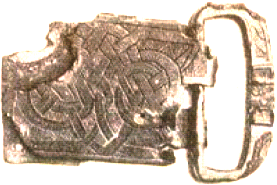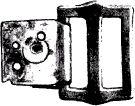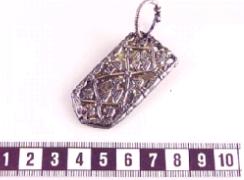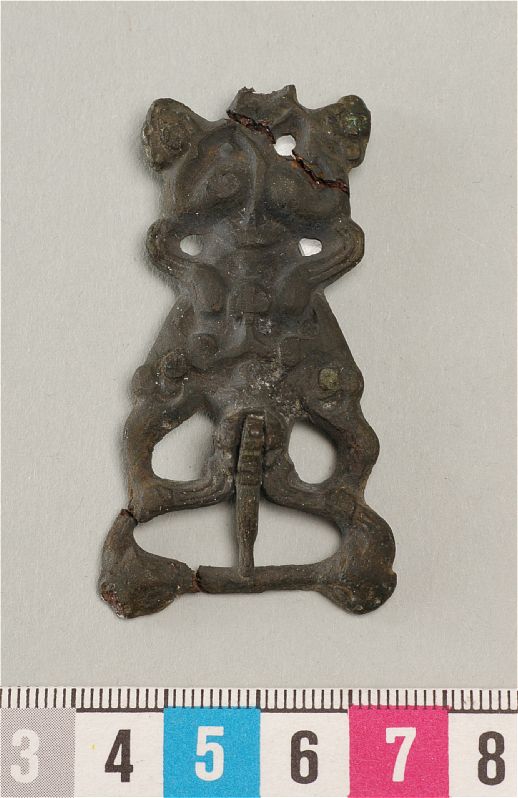Medieval Baltic


The Viking Age
- A sewing basket
- Skjoldehamn hood and tunic
- Garðar and Heynes mittens
- Mitten article translation
- Triangular shawl
- Whipcord braiding
- Images of Norsewomen
- Belt Hardware in Norse Female Graves
- Open-Fronted Apron-Dress (PDF)
- Apron, strap, and underdress textiles (PDF)
- Runic embroidery and leatherwork
- Moksha puloker braids
- Omega brooches (PDF)
Belts in Viking Women's Graves: Appendix
Liebe deutsche Besucher,
Man kann eine Übersetzung dieser Webseite in deutscher Sprache unter:http://www.derglasperlenmacher.de/ueberglasperlen/kurioses--einmaliges/frauen-und-guertel.html von Torben Barthelmie.
The Find-List:
Please note: None of the links below have been checked (in September 2022) for currency. There is almost certainly link rot.
<< Return to main page about belt buckles.
Belts with Metal Fittings
Due to metal being better-recorded in archaeological reports than textile or leather remains, especially when it comes to 19th century discveries, the easiest variety of belt to survey is the sort with an extant buckle and/or strap-end.
The vast majority of these belt findings are from, or possibly imported from, Celtic-Norse regions (Blindheim, 1976) although there may be exceptions.
Places with belt hardware in female graves:
England
- In the 10th century grave sk27 in Cumwhitton, Cumbria, in North-west England, a 'copper alloy belt fitting around the waist' was discovered in 2004. The grave has been tentatively identified as female (The Norse Burial Ground at Cumwhitton), although Simpson (2009) lists its sex as 'male/female'. The buckle was mounted on seal skin, and the find is currently described as a garment rather than a belt (Watson, 2009-10). Without further published information, it is difficult to draw any conclusions.
The buckle and skin remains are photographed in Watson (2009-10).
- A female grave from Bhaltos (formerly Valtos), Uig, Isle of Lewis (Gordon, 1990), contained a bronze buckle plated with silver (Grieg, 1940) with a knotwork design on the plate (Macleod, 1915). It is described as being 1.4 wide x .6 inches thick (≈ 35 x 15 mm) (ibid.) In total it is 50mm long, with the buckle plate 35-40 mm long, and the buckle loop 40mm high (Grieg, 1940).

Above: Buckle from Macleod (1915). - A loop of a small bronze buckle with Borre-style interlace was found near a female grave at Cruach Mor, Islay. It was 25 mm long and 1.2 mm(!) wide. (Gordon, 1990)
It is illustrated in Gordon (1990). - Cnip headland (formerly Kneep), on the Isle of Lewis revealed a 10th century female grave containing a bronze buckle, matching strap-end and studs located 'across the lower left ribcage' of the skeleton (Welander et al., 1987; Gordon, 1990). Between the buckle and strap-end plates, it appears leather fragments remained. The ring was cast as a solid loop, and the tongue was bent around it, while the rest of the belt set was made from sheet metal (Welander et al., 1987).
The buckle was 117 mm long, 16 mm wide and 12 mm thick, while the strap-end was 93 mm long, 14 mm wide and 12 mm thick (ibid.). There is an additional photograph of this set at the National Museums Scotland website. - Gordon (1990) had mentioned there was a female grave from Kildonan, Eigg containing a buckle. However, of the two graves with buckles mentioned in Grieg (1940; 69) the first with acanthus leaf decoration is considered to be a male grave (National Museums Scotland) and the second grave does not have a specified gender and was buried with a sword (Grieg, 1940). This second buckle is not mentioned in MacPherson (1878-9).
For the sake of completeness, however, an image of the probable buckle is below. It was 65 mm long and 15 mm at it's widest.
Above: Buckle from Grieg (1940).
- A grave from Daðastaðir, contained a copper-alloy belt buckle 'said to be adorned with two highly stylised animal heads.' It was 15 mm long and 25 mm wide. (Hayeur-Smith, 2003a).
- A strap-end, similar to the Cnip headland piece, from Kroppur, Eyjafjarðarsýsla, (Hayeur-Smith, 2003b) has also been found with leather remains between the bronze sheeting (Hayeur-Smith, 2003a).
- Note: There are more iron buckles found in Icelandic female graves, who were also buried with horses. However these seem to be associated with the horse tack, and not female dress (Pétursdóttir, 2007).
- A burial on Peel, St Patrick's Isle, contained a matching copper alloy buckle and strap-end (Freke and Allison, 2002). Grave IV, did not contain stereotypically female grave goods, so it is only tentatively identified as female.
The buckle was found at the waist, while the strap-end hung down to the knee. 'Near to, but below' the buckle were some fragments that may have been contained by, or were part of a pouch or purse suspended from the waist.
The buckle was 50mm long while the strap-end is 42 mm long. It is illustrated in Freke and Allison (2002).
- There is a buckle from a 9th century womans grave at the trading centre of Kaupang, however it has been interpreted as a Celtic import (Blindheim, 1976.) This is likely due to the extensive contact and trade between Norway and the British Isles at the time (Hayeur Smith, 2003b).
It is illustrated in figure 23 of Blindheim (1976).
- A double cremation burial from Timerevo, outside of Yaroslavl, Russia, included a teenage girl buried with a strap end, strap mount and circular brooch of bronze, but no paired brooches (Duczko, 2004; 195). Duczko describes this as a Norse grave, presumably dated from the late 9th to the mid 10th centuries, (ibid. 191-3).
- A 16-18 year old woman was buried in a 10-11th c. 'Scandinavian type' chamber grave from Kiev, along with a bronze belt buckle (Ivakin, 2004-5), but no paired brooches. In a reconstruction drawing, this buckle has been interpreted as fastening a belt that held a belt-pouch (ibid.) This grave also illustrates the importance of knowing the position, and any modification, of belt fittings within the grave; her necklace included two Magyar-styled silver belt fittings, that had riveted suspension loops.
- Reay, Caithness (Gordon, 1990) was the site of a woman's 10th century grave discovered in 1912 (National Museums Scotland). The small, tin-plated bronze buckle was of "a square undecorated type, and has still attached to it a small piece of the metal mounting by which it was attached to a leather belt or strap" (Curle, 1914). There is a colour photograph at the National Museums Scotland website, and another page with a more detailed description of the find.

Above: Buckle from Curle (1914). - North of Caithness, lay the Orkney Islands and Westness on the island of Rousay. A burial was discovered in 1963 of a 9th century women (Graham-Campbell and Batey, 1998) who may have died in childbirth (as her newborn was buried beside her). Along with oval brooches and other grave goods, she was buried with two bronze Anglo-Saxon strap ends (Batey; SCRAN).
Image ID: 000-000-099-764-C at SCRAN.
- Strap ends have been found in female graves at Birka, (Welander et al., 1987 quoting Geijer, 1979; 221), however they have been largely interpreted as being worn as decorative pendants in the 9th century (Ericsson and Carlsson, 2001). An example of a modified strap-end, is from the 9th century grave Bj 838 (Jansson, 1986).
An example outside of Birka is the belt fitting from a double cremation grave at Dragonbacken, Gran Parisk, Uppland (Bratt, I 2001 45, 48; Bratt, II 2001, 57).

Photograph by Yliali Asp, SHM, of the modified strap end from Bj 838. - Birka cremation grave Bj 456, identified as female but containing no paired brooches, included a buckle (Mälarstedt, 1986), below.

Photograph by Ny Björn Gustafsson, SHMM, of the buckle from Bj 456.
Used under a Creative Commons License. - From the graveyard at Alsike hage, dated 900-950 CE, grave L45 contained a copper-alloy buckle and strap end (Höglund, 2008; 25-6). The strap-end was much wider than the buckle, and possibly silver plated so they may not have been a pair (Höglund, 2008; 26). At most, the buckle was about 2.5 cm wide, and 0.5 cm thick, while the strap end was 5.6 cm by 1.5 cm wide, and 0.3 cm thick (ibid. and Mittelalter-Forum, 2010).
- Archaeologists at Fröjel on Gotland have also, apparently, discovered female graves containing buckles, although the information is very brief. A 1999 report (Excavations Report 1) mentions a female skeleton "equipped with a knife, a belt bucket (sic), a bead necklace and a pendant in the form of a coin struck for king Ehtelred of England around the year 1000."
In 2001 a woman found in a 9-11th c. grave, was buried wearing two animal-head brooches, and "two knifes that had been hanging from her belt," along with other accessories (Dahlström).
Indirect evidence of belts
Belt Pouches
- Belt pouches are seemingly associated, when worn by women, with seiðr or 'Viking shamanism' (Price, 2004). Information about this religious practice comes from medieval Icelandic texts and archaeology.
- A 10th century grave from Fyrkat, Denmark, believed to have belonging to a volva had henbane seeds 'grouped together near the woman's waist in a manner which suggests that they had originally been gathered in some kind of belt-pouch made of organic matter that has since decayed' (ibid.).
- The Oseberg 'Queen' was found with a leather pouch remains containing cannabis seeds, although if it was worn on the body, and on a belt is uncertain (Vindheim, 2002).
- A medieval source for the belt pouch, is Eiríks saga rauða (Saga of Erik the Red). Thorbjorg the prophetess was described as wearing a soft belt and there (on it) was a large purse of skin (Own translation, referring to Cleasby and Vigfusson, 1874). (Hon hafði um sik hnjóskulinda, ok var þar á skjóðupungr mikill...) (Gordon and Tayler, 1956).
- The woollen fragment from Hedeby Harbour that has been interpreted as a panel in an apron dress has, approximately 15 cm from the top edge, a band where the fabric was worn and fulled (Hägg, 1984). This has been presumed to have been from the dress rubbing against something, that has been interpreted as a belt (Hägg, 1984).
Belts Worn by Women in Nearby Cultures
Neighbouring societies to the Norse are believed to have worn clothes that included belts. The majority of these, however, do not have belt fittings, and were preserved in most cases because of nearby metalwork on other dress layers and items (Lehtosalo-Hilander, 1984).
- In the Vendel and early Viking-age periods, the Franks to the south, both male and female, wore belts with buckles. Unlike the buckles discussed here, they also came with a counterplate that matched the buckle plate. For example, see the British Museum and Met Museum websites.
- Anglo Saxon female graves in the 5-6 centuries appear to often include a belt or girdle, although buckles themselves are rare (Owen-Crocker, 2004). By the seventh to ninth centuries, buckles declined in popularity but strap-ends were still present (ibid.) either on textile or leather belts. By the 10-11th centuries, if there is a girdle and sash it is no longer visible in artwork of women (ibid.), and Christian burial practices mean the dead are no longer buried in their finest (Jesch, 1991).
- The 10-11th century Skjoldehamn bog find, now believed to be of a Saami woman (Hügel, 2002), had a belt around her waist that was plaited or braided wool (Gjessing, 1938).
- Women from the Viking-age Liv tribe, in modern-day Latvia and Estonia, are believed to have worn woollen belts made from the sprang technique. Examples of such belts are from the 11th century cemeteries of Ikšķiles Zariņu and Salaspils Laukskola (Зарцня, 1985; Žeiere, 2005; Latvijas Nacionālais Vēstures muzejs).
- In Eura, the early 11th century grave number 56 contained a woollen tablet woven band. Found at the waist, it was believed to be holding up a bronze-spiral decorated apron, knife, and keeping a pair of mittens in place (Lehtosalo-Hilander, 1984). The band was approximately 15 mm wide, and is believed to have wrapped twice around the waist (ibid.). Belt mounts 'are never found in Finnish women's graves' (ibid.).
What would a belt be made from?
- The two main materials are likely to have been leather or wool.
- The buckle from Cnip and strap-end from Kroppur had leather fragments in between the bronze plates (Welander et al., 1987; Hayeur Smith, 2003a).
- Woollen bands techniques from other graves and areas include sprang (Zeiere, 2005) tablet weaving (Lehtosalo-Hilander, 1984), and plaiting (Gjessing, 1938). The male Mammen burial in Denmark also included possible garter bands that were approximately 10 mm wide (Roesdahl and Wilson, 1992; cat. no. 174) and finger woven (Hald, 1980).
Bibliography
- Anonymous 1999. Excavations Report Number 1
Available online through The Fröjel Discovery Programme.
Last accessed: 28th August, 2010. - Anonymous The Norse Burial Ground at Cumwhitton.
Last accessed: 28th August, 2010. - Batey, C. The Vikings in Scotland SCRAN Database.
Last accessed: 28th August, 2010. - Blindheim, C. 1976. "A collection of Celtic(?) bronze objects found at Kaupang (Skiringssal), Vestfold, Norway." Proceedings of the Seventh Viking Congress. Dublin 1973; 9-27.
Available online at Viking Society Web Publications in the PDF link 'Seventh Viking Congress'.
Last accessed: 28th August, 2010. - Bratt, P. 2001. Gravfältet vid Dragonbacken I: Undersökningsrapport med analys och tolkning (Stockholm: Stockholms läns museum)
Available online at The Stockholms läns museum
Last accessed: 28th August, 2010. - Bratt, P. 2001 Gravfältet vid Dragonbacken II: Katalogdel med anläggningsbeskrivningar, planer och profiler samt fyndteckningar. (Stockholm :Stockholms läns museum)
Available online at The Stockholms läns museum
Last accessed: 28th August, 2010. - Cleasby, R. and Vigfusson, G. 1874. An Icelandic-English Dictionary (London: Oxford University Press)
Available online at the Germanic Lexicon Project.
Last accessed: 28th August, 2010. - Curle, J. 1914. "On Recent Scandinavian Grave-Finds from the Island of Oronsay, and from Reay, Caithness, with Notes on the Development and Chronology of the Oval Brooch of the Viking Time" Proceedings of the Society of Antiquaries of Scotland 48; 292-315.
Available online through Archaeology Data Service Catalogue.
Last accessed: 28th August, 2010. - Dahlström, C. 2001? The Viking Age harbour and trading place at Fröjel, Gotland
Available online through The Fröjel Discovery Programme
Last accessed: 28th August, 2010. - Duczko, W. 2004. Viking Rus: Studies on the Presence of Scandinavians in Eastern Europe (Leiden: Brill)
- Ericsson, I and Carlsson, D. 2001. De Orientaliska beslagen i Fröjel
Available online through The Fröjel Discovery Programme [PDF]
Last accessed: 28th August, 2010. - Freke, D. and Allison, E.P. 2002 Excavations on St. Patrick's Isle, Peel, Isle of Man, 1982-88: prehistoric, Viking, medieval, and later. (Liverpool: Liverpool University Press) pp. 90-1, 96.
- Gjessing, G. 1938. "Skjoldehamndrakten, en Senmiddelaldersk Nordnorsk Mannsdrakt." Viking, Tidsskrift for Norrøn Arkeologi. 2; 27-81
- Gordon, K. 1990. "A Norse Viking-Age Grave from Cruach Mor, Islay" Proceedings of the Society of Antiquaries of Scotland 120; 151-60.
Available online through Archaeology Data Service Catalogue.
Last accessed: 28th August, 2010. - Gordon, E.V. and Taylor, A.R. 1956. An Introduction to Old Norse [Second Edition] (Oxford: Oxford University Press)
- Graham-Campbell, J. and Batey, C.E. 1998. Vikings in Scotland: An Archaeological Survey (Edinburgh: Edinburgh University Press)
- Grieg, S. 1940. Viking antiquities in Scotland (Oslo: H. Aschehoug)
Available online through the Internet Archive.
Last accessed: 28th August, 2010. - Hayeur Smith, M.M. 2003a. A Social Analysis of Viking Jewellery from Iceland (PhD Thesis: Department of Archaeology, University of Glasgow)
Available online through the Glasgow University Thesis Repository
Last accessed: 28th August, 2010. - Hayeur Smith, M. 2003b. "Dressing the Dead: Gender, Identity and Adornment in Viking-Age Iceland" in Vinland Revisited, the Norse World at the Turn of the First Millennium (St. Johns: Historic Sites Association of Newfoundland and Labrador Inc.) pp. 227-240.
Available to download from Michele Hayeur Smith's Academia.edu Profile.
Last accessed: 28th August, 2010. - Hägg, I. 1984. "Die Textilfunde aus dem Hafen von Haithabu" Berichte über die Ausgrabungen in Haithabu. 20 (Neumünster: Karl Wachholtz Verlag)
- Höglund, M. 2008. Gravar i Alsike hage: Analys av fyndkontexter och gravkonstruktioner tillhörande gravfältet RAÄ 26 i Alsike socken, Uppland (Stockholm University: Independent thesis Advanced level)
Available online through DiVA Portal.
Last accessed: 26th November, 2010. - Hügel, V. 2005. “paa en Stang Struden efter hannem bære". Forskning på hetter og struthetter fra Nordens middelalder. (University of Tromsø: Masters Thesis in Archaeology).
Available online through Munin.
Last accessed: 28th August, 2010. - Ivakin, G.J. 2004-5 'Skandinavianska gravfynd i Kiev' Historiska Nyheter; 50-3.
- Jansson, I. 1986. "Gürtel und Gürtelzubehör vom orientalischen Typ" in Birka II:2. Systematische Analysen der Gräberfunde (Stockholm: Kungl. Vitterhets Historie och Antikvitets Akademien); 77-108.
- Jesch, J. 1991. Women in the Viking Age (Woodbridge, UK: The Boydell Press)
- Latvijas Nacionālais Vēstures muzejs Research and Replicas
Last accessed: 28th August, 2010. - Lehtosalo-Hilander, P.-L. 1984. Ancient Finnish Costumes (Helsinki: The Finnish Archaeological Society)
- Macleod, D.J. 1916. "An Account of a Find of Ornaments of the Viking Time from Valtos, Uig, in the Island of Lewis" Proceedings of the Society of Antiquaries of Scotland 50; 181-9.
Available online through Archaeology Data Service Catalogue.
Last accessed: 28th August, 2010. - MacPherson, N. 1878-9. "Notes on Antiquities from the Island of Eigg" Proceedings of the Society of Antiquaries of Scotland 12; 577-97
Available online through Archaeology Data Service Catalogue.
Last accessed: 28th August, 2010. - Mälarstedt, H. 1986. "Übriger Gürtelzubehör" in Birka II:2. Systematische Analysen der Gräberfunde (Stockholm: Kungl. Vitterhets Historie och Antikvitets Akademien); 109-110.
- Mittelalter-Forum, 2010. Birka - Gürtel bei der Frauengewandung
Last accessed: 26th November, 2010. - National Museums Scotland/SCRAN Database
Last accessed: 28th August, 2010. - Owen-Crocker, G.R. 2004. Dress in Anglo-Saxon England [second ed.] (Woodbridge, UK: The Boydell Press)
- Pétursdóttir, Þ. 2007. "Deyr fé, deyja frændr". Re-animating mortuary remains from Viking Age Iceland (University of Tromsø: Masters Thesis in Archaeology).
Available online through Munin.
Last accessed: 28th August, 2010. - Price, N. 2004. "The Archaeology of Seiðr: Circumpolar Traditions in Viking Pre-Christian Religion Brathair 4(2): 109-26.
Available online through the Brathair: Celtic and Germanic Study Group.
Last accessed: 28th August, 2010. - Roesdahl E. and Wilson, D. [eds.] (1992) From Viking to Crusader: The Scandinavians and Europe 800-1200 (New York: Rizzoli Publishing)
- SCRAN Scottish database with archaeological finds.
Last accessed: 28th December, 2009. - Simpson, F. 2009. "Cumwhitton Norse Burial" in Metal Detecting and Archaeology (Woodbridge: Boydell Press).
- Staatens Historiska Museet database of archaeological finds in Sweden.
Last accessed: 28th August, 2010. - Vindheim, J.B. 2002. "The History of Hemp in Norway" Journal of Industrial Hemp 7(1); 89-103.
Available to download from: Vindheim-Garnet.
Last accessed: 28th August, 2010. - Watson, J. 2009-10. "Hollow swords and needles in a soil block: Unravelling the evidence preserved on the artefacts from the Viking cemetary at Cumwhitton, Cumbria" English Heritage Research News 13; 14-16.
Available online through English Heritage.
Last accessed: 28th August, 2010. - Welander, R.D.E., Batey, C. and Cowie, T.C. 1987. "A Viking Burial from Kneep, Isle of Lewis" Proceedings of the Society of Antiquaries of Scotland 117; 149-174.
Available online through Archaeology Data Service Catalogue.
Last accessed: 28th August, 2010. - Зарцня, А.З. 1985. "Одежда жителей латвии VII-XVII вв." Рабинович, M. Г. Древняя одежда народов восточной ЕВРОПЫ (Mockba: Nauka)
- Žeiere, I. 2005. "Archaeological Evidence of Ancient Liv Costume in Latvia" in Sari Mantyla [ed.] Rituals and Relations (Helsinki: Academia Scientarum Fennica)
